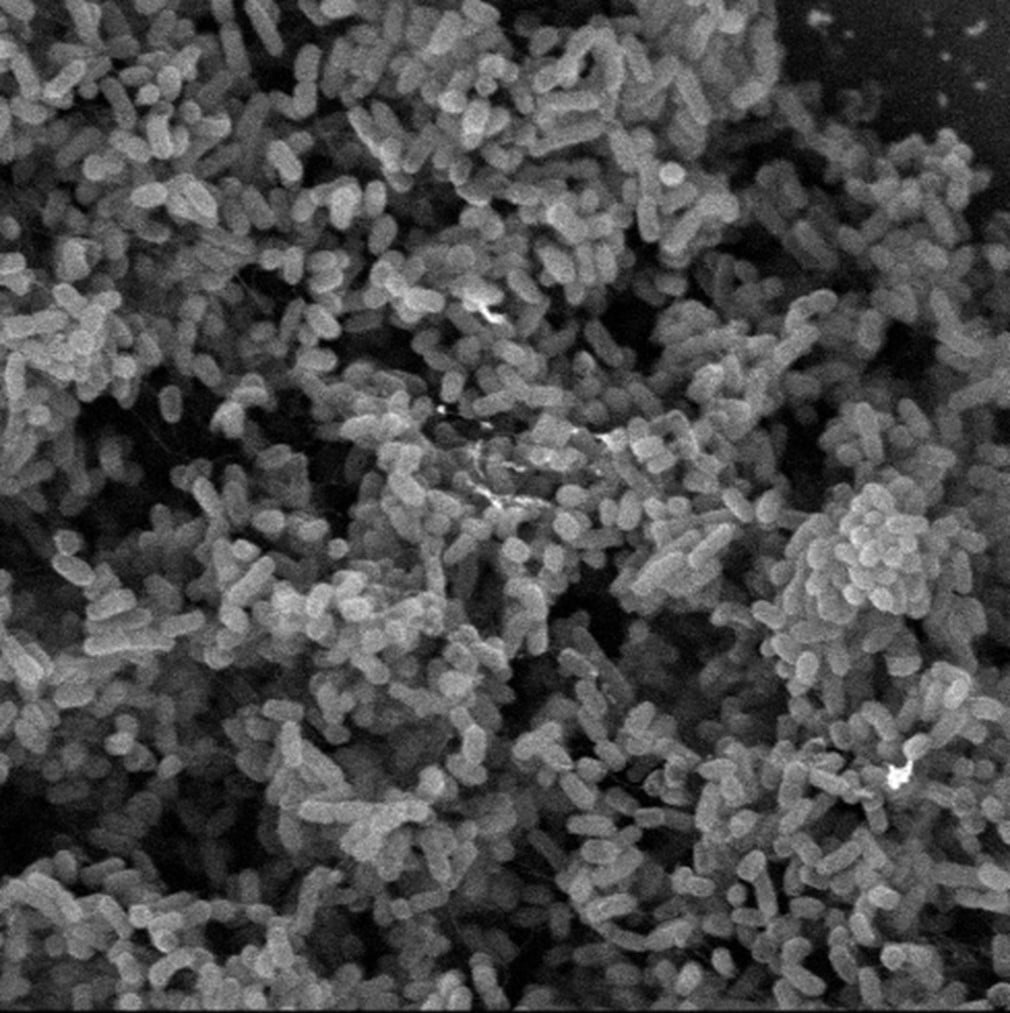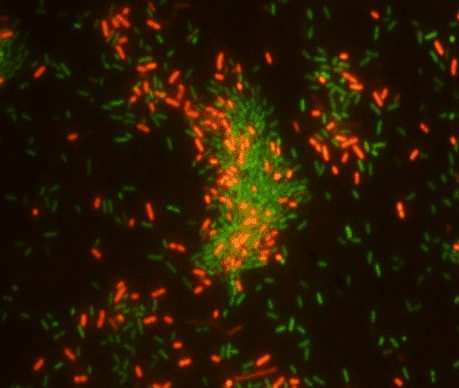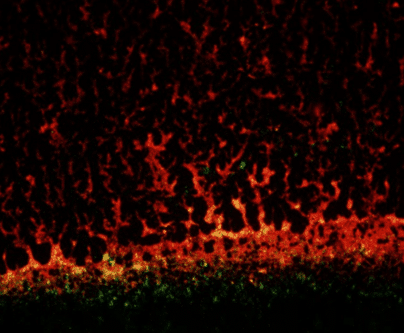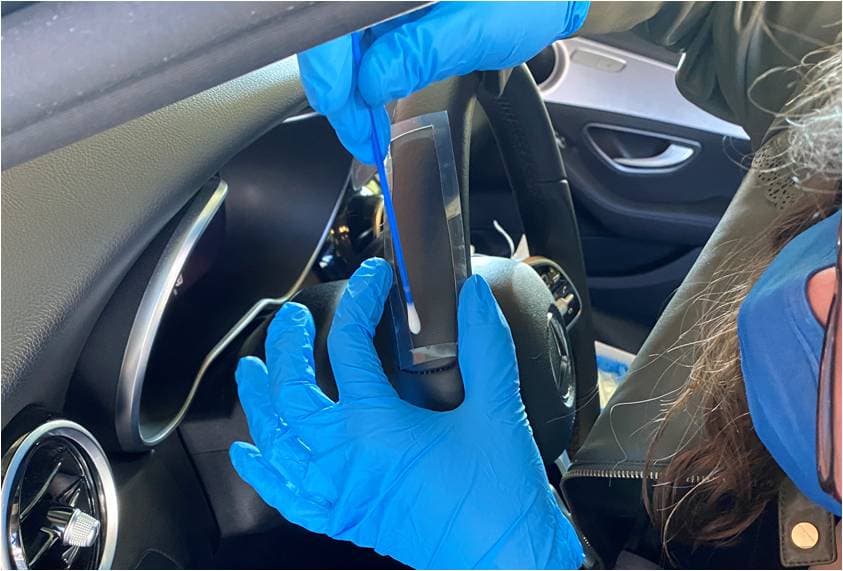What is microscopy for biological samples?
Microscopy for biological samples is a fundamental discipline in research and quality control, which allows observing and analyzing structures invisible to the human eye, such as bacteria, fungi and biofilm.
In this context, INFINITIA uses fluorescence optical microscopy and scanning electron microscopy (SEM-EDX) techniques to provide accurate and detailed analysis of microorganisms and their interactions with surfaces. These techniques combine the ability to generate high-resolution images with specific staining methods, allowing the identification of morphologies, distributions and patterns of bacterial accumulation.
Thanks to this approach, INFINITIA researchers and technicians can obtain critical information for sectors as diverse as food, environmental, industrial and biomedical.

How does microscopy for biological samples work?
At INFINITIA, the process begins with the preparation and fixation of the samples, followed by their analysis in the most appropriate equipment depending on the objective of the study.
The optical microscope with fluorescence module uses specific light sources and optical filters that excite fluorochromes attached to bacteria or their exopolysaccharides, allowing these structures to be highlighted against the background of the sample. This allows not only morphological observation, but also semi-quantification of the biofilm generated.
On the other hand, SEM-EDX projects an electron beam onto the surface of the sample, generating high-resolution images and allowing the identification of the areas of greatest bacterial accumulation, their spatial distribution and morphology with a high level of detail. In addition, EDX coupling provides elemental information, which expands the ability to characterize the analyzed surface.
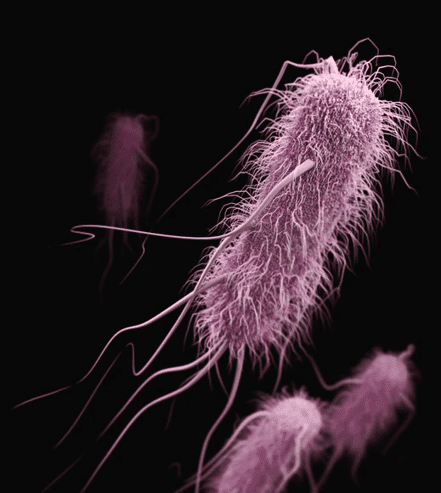
Benefits of microscopy for biological samples
The combination of fluorescence optical microscopy and SEM-EDX used at INFINITIA provides a comprehensive view of biofilm and other microbiological elements, uniting observation at the cellular level with structural and compositional analysis.
This dual approach allows, for example, to relate the quantity and distribution of bacteria with physicochemical characteristics of the surface, optimizing cleaning processes, effectiveness of detergents, biocides, antimicrobial treatments and antibiofilm, or the realization of hygiene maps and critical points analysis (HACCP).
In the food industry, these techniques help to detect and control biofilm formation in production lines, while in the biomedical sector they can be applied to study microbial colonization in medical devices. The sensitivity and resolution achieved provide reliable data to support technical decisions and improvement strategies in various industrial environments.
Microscopy equipment for biological samples at INFINITIA
For these analyses, INFINITIA has the Olympus BX53U optical microscope with fluorescence module for biological analysis, which allows the application of specific staining techniques and motorized scans of large sample areas.
In addition, the Phenom ProX desktop SEM scanning electron microscope combines high-resolution imaging with chemical microanalysis by EDX, which significantly extends the scope of characterization. Unlike other equipment on the market, this combination in INFINITIA allows correlating optical and electronic information of the same sample, optimizing the interpretation of results.
In addition, the internal protocols comply with ISO 16700:2016, ensuring accurate calibration of SEM magnification, a key aspect to guarantee the reliability of quantitative analyses.

Microscopy applications for biological samples.
At INFINITIA, the combination of optical microscopy with fluorescence and scanning electron microscopy (SEM-EDX) makes it possible to approach the analysis of biological samples with a comprehensive perspective. This versatility facilitates the application of these techniques in multiple industrial and research sectors, guaranteeing accurate and reproducible results.
Biofilm analysis is one of the most relevant applications. Using the BX53U optical microscope with fluorescence module, it is possible to stain bacteria and exopolysaccharides to visualize the three-dimensional structure of the biofilm, evaluate its morphology and perform a semi-quantitative estimation of its concentration through image analysis tools.
SEM-EDX complements this analysis by allowing to observe the surface topography and to locate areas of increased bacterial accumulation, as well as to study the spatial distribution in relation to the microstructure of the substrate. This dual approach is especially useful in sectors where biofilm represents a risk to product safety or quality, such as in the food, pharmaceutical or water treatment industries.
Contamination control in industrial environments
Microscopy for biological samples is key to detect and control the presence of microorganisms in production lines. At INFINITIA, it is used both for the verification of cleaning and disinfection processes and for the investigation of contamination incidents.
The use of fluorescence allows rapid identification of viable bacteria or biofilm debris, while SEM-EDX provides a more detailed view of the affected areas, even assessing whether the surface microstructure favors bacterial adhesion. This information is essential for optimizing hygiene protocols and selecting materials with better antimicrobial performance.
In the field of research, these techniques make it possible to study how bacterial communities develop and organize under different conditions. The possibility of correlating optical and electronic images opens new opportunities to understand adhesion and growth mechanisms, as well as to evaluate the effect of antimicrobial treatments or protective coatings.
INFINITIA collaborates with companies inmaterial innovation projects , product development and technologies to improve the resistance of their products against microbial colonization.
Biomedical sector and medical devices
Biofilm formation on implantable or reusable medical devices is a critical problem that can lead to persistent infections.
Fluorescence microscopy allows identification and quantification of the bacterial load, while SEM-EDX reveals details of the interaction between the material and the bacteria.
These analyses help to evaluate the performance of medical materials and to validate sterilization treatments, contributing to improved patient safety.
In forensic engineering, these techniques are used to investigate failures related to microbiological contamination. INFINITIA uses microscopy for biological samples to determine whether a biofilm has contributed to the degradation of a component or the disruption of a system.
The information obtained can be instrumental in establishing root causes and developing corrective measures.
Development of new materials and coatings
Microscopy for biological samples is also essential for evaluating materials with antimicrobial properties. Tests performed at INFINITIA make it possible to determine whether a coating reduces bacterial adhesion or limits biofilm formation.
By combining fluorescence observation with SEM-EDX topographical and compositional analysis, a complete picture of material performance under real or simulated conditions is obtained.
INFINITIA as a strategic partner in microscopy analysis of biological samples
Microscopy for biological samples is an essential tool to understand, characterize and control the presence of microorganisms in a wide range of industrial and research sectors. At INFINITIA, the strategic combination of the BX53U optical microscope with fluorescence module and the Phenom ProX desktop SEM scanning electron microscope with EDX microanalysis allows us to approach this type of studies with a complementary approach: fluorescence offers fast and accurate visualization of bacteria and exopolysaccharides, while SEM-EDX provides high-resolution structural and compositional information.
This methodological integration not only provides high-quality visual data, but also enables semi-quantitative biofilm analysis, assessment of bacterial distribution and correlation with physicochemical surface properties.
In applications ranging from industrial hygiene control to the validation of medical devices, from failure investigation to the development of new antimicrobial materials, these techniques allow informed decisions to be made and processes to be effectively optimized.
At INFINITIA we continue to focus on innovation and the use of advanced technology in our laboratories to provide accurate and high quality results. Thanks to our experience and investment in state-of-the-art equipment, we guarantee efficient solutions adapted to the needs of the industry.
Here are some examples of the use of microscopy of biological samples at INFINITIA:

